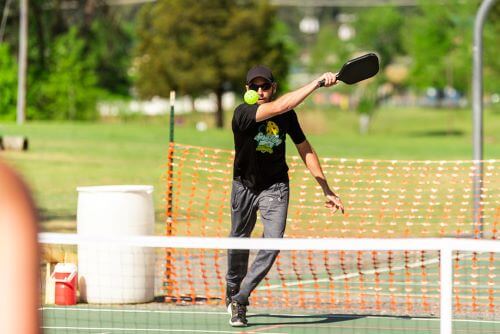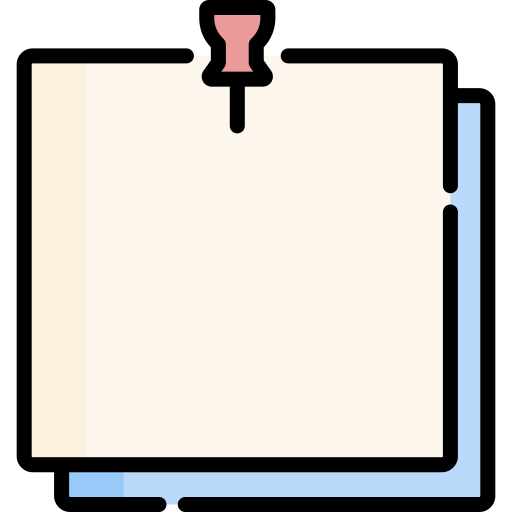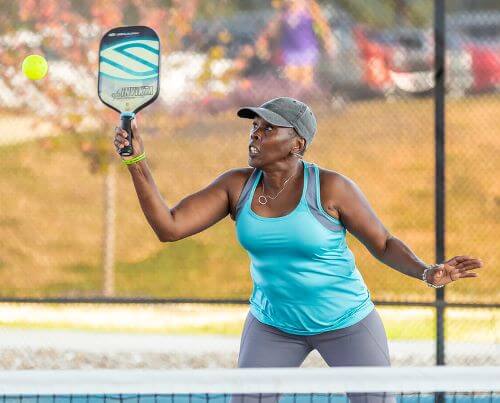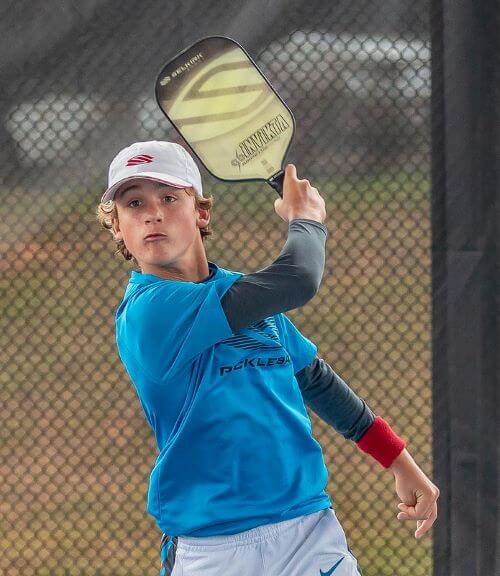Overhand shots in pickleball can be quite confusing. There are rules that are clearly against it, but those rules only apply to certain situations. This means that there are situations that allow you to hit an overhand in pickleball.
We’ll be clarifying everything there is to know about hitting overhand shots in pickleball, as well as doing a deep dive on the topic.
In this article, you’ll read through the official rules, the difference between underhand and overhand, when the best time to use an overhand is, and some tips to help you hit better your overhand shots in pickleball.
What’s the Difference Between Overhand and Forehand Shots?
Forehand and overhand are two types of swings that are often confused with each other. This is because the grip and swing are almost identical, especially when explained.
A forehand is a swing from the side that’s holding your paddle. If you’re holding your paddle on the right, then a swing from the right is a forehand. Forehand swings have their paddles “open”, with the face slightly tilted to face upwards.
On the other hand, an overhand shot is a downward swing from anywhere above your shoulder level. It kind of looks like a smash in tennis or badminton or a spike from volleyball. These shots are great for generating tons of power downwards, creating a fastball that’s hard to return and bounces far away.
Can You Hit Overhand in Pickleball?
Yes, you can hit overhand in pickleball.
In fact, there will be a lot of situations where you need to use an overhand shot to win the rally. When done right, an overhand shot is one of the strongest moves you can do in pickleball.
The only time an overhand is not allowed is during the serve. You’re not allowed to hit overhand when serving because it’s against the rules and goes against the spirit of the 2-bounce rule—which is to make the serves fair.
Official Rules About Overhand Shots in Pickleball
According to the USA Pickleball Official Rulebook, there are only two kinds of serves: the volley and drop serve. Technically speaking, only the volley serve prohibits overhand shots when serving in pickleball. Rules 4.A.7.a. of the volley serve states:
As well as 4.A.7.b., which says:
And 4.A.7.c. that states:
All three of these rules fall under the volley serve and basically prohibit any kind of overhand motion. On the other hand, the drop serve explicitly has a rule that says:
Even if it is legally allowed in the service, it’s basically impossible to do an overhand serve from a drop serve. Yes, you can serve downward, but the drop serve works by “dropping” the ball from any natural, unaided height. This means no jumping before you drop the ball. So, once the ball bounces back, the height of the ball won’t be physically high enough for an overhand serve anyway.
Is It a Fault when I Hit an Overhand Shot in Pickleball?
The only time an overhand shot is considered a fault in pickleball is when it’s used in a serve.
Outside of that, the overhand is a great shot for pickleball players and should be used whenever there’s an opportunity.
When to Hit an Overhand in Pickleball?
Although an overhand is a difficult shot to return, knowing when you can do an overhand is more difficult.
This skill comes in the time since it involves being familiar with how the pickleball moves, how long it takes to land, and where the pickleball is going. You’ll also need to time your strike, which means understanding how long it takes for you to swing overhand.
We’ll talk more about the tips you can use to improve your overhand shots after this section. Before that, let’s discuss when to hit an overhand in pickleball.
After Serving to Catch Your Opponents by Surprise
Doing an overhand right after service can catch some opponents off-guard, forcing them to quickly return or move toward your shot. This helps you dictate the pace of the game.
The reason why this works is that your opponent has to wait for the ball to bounce on their side of the court before they can move.
Defending Against a Lob with An Overhand Smash
Lobs are another great way to catch your opponent off-guard and control the game. If your opponent tries to do a lob but doesn’t hit the ball high enough, you can hit the pickleball back with a deadly smash. Aim and power will make a smash near impossible to return.
But the key to pulling this off is the timing. Perfectly timing yourself and using the right form will amplify the speed and strength of your smash, as well as the accuracy.
How Can You Hit Overhand in Pickleball? the Best Ways and Drills
Overhand shots might seem easy to do, but they’re one of the hardest to master. Pickleball players who don’t come from an athletic background and aren’t used to reaching above their shoulders during a game will have a hard time with overhand shots.
It’s normal for beginners or inexperienced players to feel uncomfortable and wonky. Forehand and backhand shots are one thing, but overhand shots that force you to reach out are another. Jumping and feeling like an unorganized heap of flesh is a totally common feeling. So, here’s what you can do to hit a great overhand in pickleball.
Practice
Overhand shots need a ton of practice to do right, especially if you’re trying to hit a smash or practice your aim.
The easiest drill I can suggest is to throw the ball in the air and hit it against the wall. The ball should hit the ground and bounce back to you if done correctly. Repeat this multiple times with less power and a slow swing.
Just make sure that you do a complete range of motion: Your shoulders, elbows, and arm should move back, then arch upwards, and then downwards. The ball should be in front of you when you hit it.
? Don’t throw the ball directly above you. It should be a little bit in front so that you can hit it at an angle that directs the ball downwards.
? Keep your paddle straight at all times, don’t adjust your paddle angle to compensate for incorrect positioning.
Timing
The key to a good overhand or smash in pickleball is timing. When you aren’t rushed or delayed, good form and proper technique will always generate the strongest and fastest swing.
Once you’re used to the timing of throwing the pickleball in the air and hitting it downward, it’s time to use a different drill. Instead of throwing the pickleball in the air, hit the pickleball upwards toward the wall. The ball should bounce toward the area above your head. From there, simply do an overhand swing and practice smashing the ball! You can practice jumping too once you get the hang of this.
Again, it’s important that you focus on taking it slow and perfecting your form before you start blasting the pickleball with all your might.
Position
You’ve got the timing right, but what about those times when the ball is just too high or too low?
Positioning is one of the most underrated techniques that beginners and even intermediate players overlook when it comes to pickleball. Great positioning allows for better form, accuracy, and ultimately power when smashing or doing an overhand swing. Getting yourself in the right position will make any kind of swing easier to do.
You can improve your positioning skills by keeping an eye out for lobs. Once you see a lob happening, you’ll immediately know that this is the time to use extra energy to move faster. Just the act of quickly leaning your body toward where the lob is heading will improve your positioning and the timing of your overhand shots!
Best Grips for Hitting Overhand in Pickleball
The best grips for hitting overhand shots in pickleball are the continental and eastern grips. These two grips maximize your reach and make the paddle as parallel to your arm as possible.
If you want to read more about this, we have a whole article on everything there is to know about pickleball grips.




































